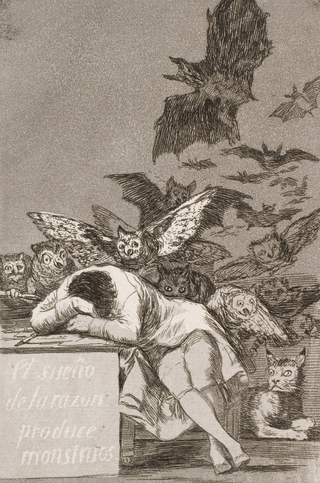Health
How Art Helps Us Think About Health
On shaping an imaginative vision for a healthier world.
Posted August 17, 2021 Reviewed by Chloe Williams
Key points
- Public health can be thought of as the pursuit of a vision for a healthier world. Art can shape a vision of a different world.
- The current aesthetic of health tends to focus on youth and fitness, but the pursuit of health increasingly concerns later stages in life.
- Art can provide a vision for what it means to live a healthier life, show a path to a better future and help convey the story of public health.
Public health is an aspiration as much as it is a technical set of skills, tasks, and methodologies. It is, at its core, the pursuit of a vision—a vision of a healthier world. To imagine a radically healthier world is to imagine a world unlike one we have yet seen. Lacking this frame of reference means we need to draw on our creative capacities in envisioning this future. Doing so takes us beyond the realm of purely technical considerations, and into that of art and metaphor. Art, through its aesthetic power, can shape a vision of a different world, one which invites the public to engage with new possibilities for how life could be. Is there any reason why the pursuit of health should be less visionary?
It is first worth asking: What do we mean by aesthetics? It is easy to think aesthetic sensibilities amount simply to taste, and, in a sense, they do. Aesthetic power speaks to our perceptions of beauty, animating our sense of the lovely, the transcendent. John Keats, one of my favorite romantic poets, closed his poem, "Ode on a Grecian Urn," with the lines, "’Beauty is truth, truth beauty,—that is all / Ye know on earth, and all ye need to know.’" This implies that when we experience aesthetic delight, we are, at the core, relishing an encounter with truth.
The Aesthetic of Health
An aesthetic for a healthier world, then, is one that reflects the truth about health. The current aesthetic of health does not always fully convey this truth. What are the sights and sounds of health? Likely, what first comes to mind are images of people exercising—perhaps a workout montage set to music from a film like Creed. Then there are young, vibrant faces beaming with fitness. Perhaps we also imagine the logo of some health food or sports drink, or the slogan of a trendy sneaker company. This is an appealing aesthetic, but is it the truth?
We, in public health, know it is not. It is a slickly packaged presentation of a highly individualized version of the pursuit of health, which does not consider the socioeconomic forces that are, in fact, the overwhelming drivers of health and disease in our society. This aesthetic also, in its focus on youth, leaves out the rest of the life-course, suggesting health is primarily something for the young, whereas the truth is that, as populations age, maximizing health becomes a project which increasingly concerns those at the mid- and later-stage of life. It is also true that a healthier world is indeed one where people live longer, healthier lives, reiterating the importance of an aesthetic that captures the experience of older adults as stylistically as it captures the comings and goings of youth.
Such an aesthetic could well take inspiration from the many older adults who have thrived in the field of art, enriching our world through their creativity. There is the renowned pianist Martha Argerich, for example, who, at the age of 80, continues to play complex pieces, from memory, with as much skill as she ever has. Then there is Françoise Gilot, who, at age 99, continues to produce masterful visual art. Or, to remain in the world of painters, there was Georgia O’Keeffe, who lived to be 98 and painted well into her older years. These women reflect how advanced age can be a time of even greater poise and productivity in one’s art than the years that preceded it. An aesthetic shaped by such examples can indeed support a new vision of what it means to live a healthier life.
Art Can Help Tell the Story of Public Health and Provide a Path Forward
We can also benefit from incorporating the work of artists into the work of public health. In preparing presentations, for example, I have often found including a piece of art among the charts and graphs I frequently use as visual aids to be very effective. Art by Goya, like the piece below, has long been helpful in discussing the effects of trauma (indeed, that work, titled "The Sleep of Reason Produces Monsters," could also well illustrate the dangers of our polarized moment). At various points, the work of Shakespeare, the life of the blues musician Blind Willie Johnson, and many other artistic allusions have been helpful in conveying the story of public health.

Finally, the aesthetics of a healthier world should incorporate art which depicts the path from where we are to where we hope to be. One of the most affecting examples of such art, to me, has long been Tony Kushner’s play, Angels in America: A Gay Fantasia on National Themes. I remember clearly the first time I saw the play at a time in my life when I was practicing clinical medicine. It felt like a representation in poetry of the prose of reality. It is a play that depicts the darkness of the HIV/AIDS crisis in a way that does not stigmatize its victims, or flinch at depicting the social forces that threatened them, while offering a near-mystical vision of how society might be transformed—indeed, transfigured—into a healthier, more just and inclusive place. There is no substitute for seeing the play in its entirety, or watching the film, but a brief summation of its power to conjure a better world is captured in its closing speech, delivered by the protagonist Prior Walter (watch here).
The play premiered in the early '90s, a time when the end of AIDS and full social equality for the LGBTQ population still seemed far off. While neither of these goals have yet been fully realized on a global scale, we are today far closer to them than we were when Angels in America premiered, showing how we can indeed progress towards a vision of a better future first depicted in the aesthetic language of art.
Health, like art, deals with universal truths about human nature and society. The shared pursuit of these truths reflects a synergy that can do much to enrich our work. An aesthetic for a healthier world is one that combines artistic insight with the rigorous, data-informed perspective of public health. Such an aesthetic, in addition to lending greater beauty to the expression of our ideas—worthwhile for its own sake—can help inform an imaginative vision of a healthier world, to help inspire a better future.


